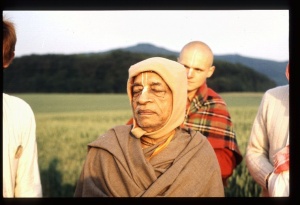CC Madhya 9.223 (1975): Difference between revisions
(Vanibot #0027: CCMirror - Mirror CC's 1996 edition to form a basis for 1975) |
(Vanibot #0020: VersionCompareLinker - added a link to the Version Compare feature) |
||
| Line 2: | Line 2: | ||
<div style="float:left">'''[[Sri Caitanya-caritamrta (1975)|Śrī Caitanya-caritāmṛta (1975)]] - [[CC Madhya (1975)|Madhya-līlā]] - [[CC Madhya 9 (1975)|Chapter 9: Lord Śrī Caitanya Mahāprabhu's Travels to the Holy Places]]'''</div> | <div style="float:left">'''[[Sri Caitanya-caritamrta (1975)|Śrī Caitanya-caritāmṛta (1975)]] - [[CC Madhya (1975)|Madhya-līlā]] - [[CC Madhya 9 (1975)|Chapter 9: Lord Śrī Caitanya Mahāprabhu's Travels to the Holy Places]]'''</div> | ||
<div style="float:right">[[File:Go-previous.png|link=CC Madhya 9.222 (1975)|Madhya-līlā 9.222]] '''[[CC Madhya 9.222 (1975)|Madhya-līlā 9.222]] - [[CC Madhya 9.224 (1975)|Madhya-līlā 9.224]]''' [[File:Go-next.png|link=CC Madhya 9.224 (1975)|Madhya-līlā 9.224]]</div> | <div style="float:right">[[File:Go-previous.png|link=CC Madhya 9.222 (1975)|Madhya-līlā 9.222]] '''[[CC Madhya 9.222 (1975)|Madhya-līlā 9.222]] - [[CC Madhya 9.224 (1975)|Madhya-līlā 9.224]]''' [[File:Go-next.png|link=CC Madhya 9.224 (1975)|Madhya-līlā 9.224]]</div> | ||
{{CompareVersions|CC|Madhya 9.223|CC 1975|CC 1996}} | |||
{{RandomImage}} | {{RandomImage}} | ||
==== TEXT 223 ==== | ==== TEXT 223 ==== | ||
| Line 11: | Line 10: | ||
<div class="verse"> | <div class="verse"> | ||
:malaya-parvate kaila agastya-vandana | :malaya-parvate kaila agastya-vandana | ||
:kanyā-kumārī | :kanyā-kumārī tāṅhāṅ kaila daraśana | ||
</div> | </div> | ||
| Line 18: | Line 17: | ||
<div class="synonyms"> | <div class="synonyms"> | ||
malaya-parvate—in the Malaya Hills; kaila—did; agastya-vandana—obeisances to Agastya Muni; kanyā-kumārī—Kanyā-kumārī; | malaya-parvate—in the Malaya Hills; kaila—did; agastya-vandana—obeisances to Agastya Muni; kanyā-kumārī—Kanyā-kumārī; tāṅhāṅ—there; kaila daraśana—visited. | ||
</div> | </div> | ||
| Line 32: | Line 31: | ||
<div class="purport"> | <div class="purport"> | ||
The range of mountains in South India beginning at Kerala and extending to Cape Comorin is called Malaya-parvata. Concerning Agastya, there are four opinions: (1) There is a temple of Agastya Muni in the village of Agastyampallī | The range of mountains in South India beginning at Kerala and extending to Cape Comorin is called Malaya-parvata. Concerning Agastya, there are four opinions: (1) There is a temple of Agastya Muni in the village of Agastyampallī in the district of Tanjoreāñ. (2) There is a temple of Lord Skanda on a hill known as Śiva-giri, and it is supposed to have been established by Agastya Muni. (3) Some say that near Cape Comorin there is a hill known as Paṭhiyā, which was supposed to have served as Agastya Muni's residence. (4) There is a place known as Agastya-malaya, which is a range of hills on both sides of the Tāmraparṇī River. Cape Comorin itself is known as Kanyā-kumārī. | ||
</div> | </div> | ||
Latest revision as of 20:52, 27 January 2020

A.C. Bhaktivedanta Swami Prabhupada
TEXT 223
- malaya-parvate kaila agastya-vandana
- kanyā-kumārī tāṅhāṅ kaila daraśana
SYNONYMS
malaya-parvate—in the Malaya Hills; kaila—did; agastya-vandana—obeisances to Agastya Muni; kanyā-kumārī—Kanyā-kumārī; tāṅhāṅ—there; kaila daraśana—visited.
TRANSLATION
Śrī Caitanya Mahāprabhu then went to Malaya-parvata and offered prayers to Agastya Muni. He then visited Kanyā-kumārī [Cape Comorin].
PURPORT
The range of mountains in South India beginning at Kerala and extending to Cape Comorin is called Malaya-parvata. Concerning Agastya, there are four opinions: (1) There is a temple of Agastya Muni in the village of Agastyampallī in the district of Tanjoreāñ. (2) There is a temple of Lord Skanda on a hill known as Śiva-giri, and it is supposed to have been established by Agastya Muni. (3) Some say that near Cape Comorin there is a hill known as Paṭhiyā, which was supposed to have served as Agastya Muni's residence. (4) There is a place known as Agastya-malaya, which is a range of hills on both sides of the Tāmraparṇī River. Cape Comorin itself is known as Kanyā-kumārī.